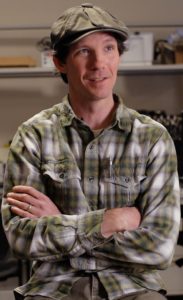Senior research scientist joins IHMC team from Georgia Institute of Technology

Greg Sawicki is joining IHMC as a senior research scientist with the robotics team.
How can you put the “spring in your step” for an exoskeleton?
The answer could exploit key principles of locomotion neuromechanics to build wearable devices that improve the economy, stability and agility of human movement.
It’s something Dr. Gregory Sawicki has been working on at Georgia Institute of Technology. Sawicki is bringing his expertise to the Florida Institute for Human and Machine Cognition as a senior research scientist.
He joined IHMC in January 2022 on a part-time appointment.
Sawicki will embed with the robotics, exoskeletons and human robotics interdependence group focusing on two broad areas.
“One is to help guide current human exoskeleton projects, such as developing exoskeletons for injury mitigation in industrial settings for the (U.S. Department of Energy) and improving controllers for the Quix Exoskeleton for improving mobility for people with spinal cord injury,” Sawicki said.
The second is to help expand the research portfolio in human-machine robot interaction by consulting on preparation of new proposals to the National Science Foundation, the National Institutes of Health and the U.S. Department of Defense, he said.
His work at the Physiology of Wearable Robotics (PoWeR) Lab has focused on how the biology behind the power of lower-limb joints can be adapted to robotic devices to help both healthy and impaired people walk better.
According to their website, The PoWeR lab’s goal is creating lower-limb wearable exoskeletons that are “symbiotic” for the wearer, maximizing the energy needed for assisted walking.
Sawicki has been working on the design of a portable, passive elastic exoskeleton and clutching mechanism that can provide ‘the spring in your step’ by storage and release of elastic energy in a parallel elastic element worn about the ankle — an exo-tendon of sorts — while walking.
As part of IHMC, Sawicki maintains his status as associate professor at Georgia Tech, where he splits his time with appointments in both the School of Mechanical Engineering and the School of Biological Sciences.
He earned a bachelor’s degree from Cornell University and a master’s in mechanical engineering from the University of California-Davis. He finished his Ph.D. in human neuromechanics at the University of Michigan at Ann-Arbor. He also worked as a National Institutes of Health-funded post-doctoral Fellow in integrative biology at Brown University.
Latest News
- IHMC Unveils New Leadership Team to Build on Legacy of Innovation
- Ocala Research Showcase highlights IHMC’s footprint and impact
- STEM-Talk wins Signal Award in Health & Wellness Podcasts
- STEM-Talk: Rudy Tanzi on genetics, aging, and the hallmarks of Alzheimer’s
- National Institutes of Health award for $7.7 million to determine how people over 60 attain the health benefits of exercise
- STEM-Talk: Anurag Singh on aging, exercise, and urolithin-A
- STEM-Talk: Kevin Tracey on bioelectrical medicine and inflammation’s toll
- Evening Lectures focus on human performance, work culture and much more
- Science Saturdays schedule for Fall 2024 released

